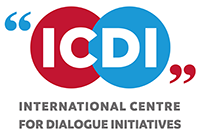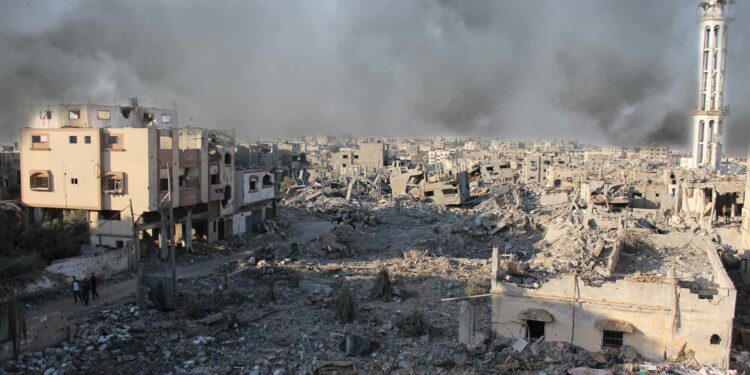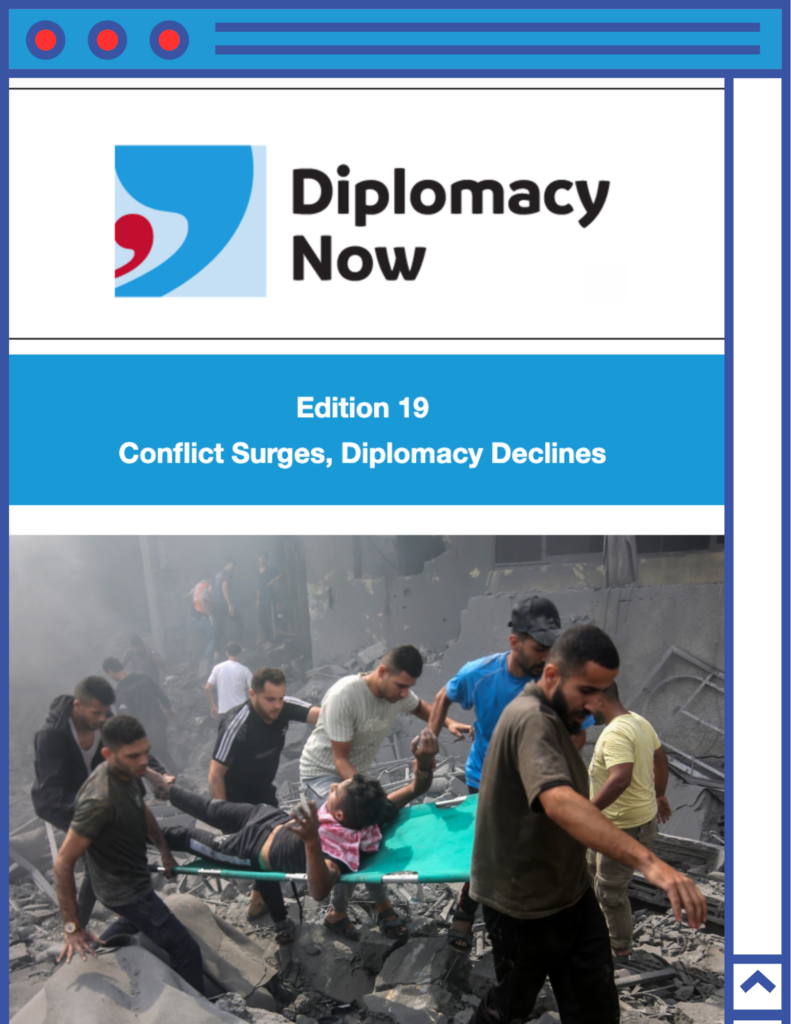As the latest chapter in the conflict between Israel and Palestine unfolds with devastating consequences for civilians, little attention has been paid to the role that diplomacy has played in the past and might play in bringing the bloodshed to an end. This article focuses on four issues that will define the trajectory of the conflict. First, how the showdown between Israel and Hamas could lead to an unprecedented humanitarian catastrophe in the region. Second, there is an open-ended question about the decline of diplomacy and moral politics, so far, vis-à-vis the United States’ realpolitik approach toward supporting Israel and trying to erase Hamas as a ‘security threat.’ Third, it is also a moment for reflection on the US-supported normalization accords with Israel that were underway in the Middle East, that have been halted with Saudi Arabia informing the Biden Administration “to stop any discussions related to normalization with Israel.” Fourth, the article explores potential mediation efforts that could end 75 years of failed conflict management.
The bleak humanitarian horizon and a deadlier chapter in the conflict
The humanitarian horizon is bleak as both Eretz and Rafah crossing points remain closed respectively on the Israeli and Egyptian borders. This situation has worsened since Defense Minister Gallant ordered a “complete siege” of the Gaza Strip. Lyse Doucet, BBC’s long-time observer of the conflict, remarked how Israel, in past wars, vowed to “hit Hamas hard,” to destroy its capacity to fire rockets into Israel, including its vast web of subterranean tunnels, now “Israel is vowing to destroy Hamas,” suggesting the conflict might reach an unprecedented level of violence and destruction.
Public international law and the United Nations Charter govern the legality of the resort to force between States. This is referred to as ius ad bellum, which encompasses the principles of necessity, proportionality, and precautions. As one analyst at the West Point’s Lieber Institute wrote, “one may question whether the ordered complete siege of the Gaza Strip could constitute a violation of International Humanitarian Law (IHL).” UN Relief Chief, Martin Griffiths, stated “hundreds of people have been killed. Gaza is on its knees.”
UNSC resolution for temporary ceasefire thwarted by the US
The United States vetoed a Brazil-drafted resolution that condemned violence against all civilians and called for pause in fighting to allow humanitarian assistance into Gaza. US ambassador Linda Thomas-Greenfield stated the draft resolution did not do enough to underscore Israel’s right to self-defense, and later told the press: “We are on the ground doing the hard work of diplomacy. We believe we need to let that diplomacy play out.” Twelve members of the Security Council voted in favor of the draft resolution and Russia and the United Kingdom abstained.
The Biden administration has apparently opted for supporting Israel in its pursuit of eliminating Hamas. This strategy of fully destroying a political, social and military movement, with deep-rooted political, nationalistic and cultural underpinnings of popular resistance in Gaza as well as the West Bank, seems to be ill-strategized and pointless. Overall, 57 percent of Gazans express at least a somewhat positive opinion of Hamas —along with similar percentages of Palestinians in the West Bank (52 percent), and East Jerusalem (64 percent), according to a recent Washington Institute survey conducted in July 2023.
Similar movements such as Sadrist Movement led by Muqtada al-Sadr in Iraq and the Taliban in Afghanistan have not disappeared from the political map. Consequently, there has been a paradigm shift in Middle Eastern politics as these non-state actors have outperformed local states in altering the balance of power. As UN Chief António Guterres highlighted: “the most recent violence does not come in a vacuum, but grows out of a long-standing conflict, with a 56-yearlong occupation and no political end in sight.”
The failures of Oslo and Abraham Accords
The new cycle of violence has pointed to serious shortcomings of the Oslo Accords (1993) as well as the so-called ‘Abraham Accords.’ Israel has undermined two main conduits of its strategy for normalization with Arab states: ‘Peace for Land’ with Egypt in 1978 and Jordan in 1994, and ‘Peace for Peace’ with the Emirates, Bahrain, Sudan, Morocco. Then-President Jimmy Carter’s National Security Adviser late Zbigniew Brzezinski recalled the divergent temperaments of the two delegations: “The Israeli prime minister was strategically focused and intransigent in negotiating style, while the others in the delegation were more flexible.” In contrast, “The Egyptian delegation was headed by a president quite determined to succeed, who was a visionary and conciliatory, but his tough-minded entourage was more inclined to feel [Sadat] was making too many concessions.”
In the pre-2020 Abraham Accords diplomatic exchange, the modalities of Arab-Israeli negotiations were not under the jurisprudence of the Kushners in 2020 during the Trump administration. There were at least three embedded failures during the process of negotiation: The Arab parties assumed the Iranian-Arab enmity would be eternal. They did not take into account that the philosophy of international relations is in constant convergence/divergence of strategic interests, and not a policy of rigid values that are not wetted by the waters of the Gulf, as is currently happening between Riyadh and Tehran, and even between Abu Dhabi and Tehran.
A second factor that led to the failure of the Abraham Accords, was an assumption that the era of nationalism and Pan-Arab identity had ended, and that we are in a new era of national interests, not nationalism. For example, the slogan “Taza before Gaza” was drawn from this hypothesis to help convince Moroccans refrain from their advocacy of moral politics and support for the Palestinian cause. Instead, the new slogan ushered to the priority of national imperatives namely Morocco’s position toward the Western Sahara conflict. Normalization with Israel was also perceived as a tactic that could help kill two birds with one stone: to defeat Arab nationalism and to contain the Islamist movements, and ultimately to bury Arab nationalism and Islamic nationalism in the same grave.
A third factor is that the normalization agreements adopted the philosophy of Netanyahu’s constructed slogan “peace for peace.” This vague motto seems to contradict the long history of treaties that are always based on exchanging tangible gains for reasonable concessions. It is merely “authoritarian conflict management.”
After the signing ceremony of the Bahraini-Emirati-Israel agreement at the White House in September 2020, Tamara Cofman Wittes of the Brookings Institution made a sound projection. She said, “The reality of Palestinian politics is that the overall stalemate, the threat of annexation, and now the Emiratis and Bahrainis making their separate arrangements will cause the Palestinians to dig in. This all just reinforces an instinct toward resistance.” Five wars and tens of thousands of casualties mostly Palestinians in a turbulent period of eighteen years (2005-2023). While speaking before the Security Council, UN Middle East peace envoy Tor Wennesland echoed significant concern: “the world is at the brink of a deep and dangerous abyss that could change the trajectory of the Israeli-Palestinian conflict, if not of the Middle East as a whole,” he said.
Time for the UN to step up and a more active diplomacy in the conflict
The Arab governments involved in the Abraham-Accords have been reluctant to announce a clear stance toward Israeli actions and threats against Gaza. They have served as de-facto political tools of burying the ‘Two-state Solution’. Israel has secured four friendly pro-Likud governments in the Gulf, east Africa and the Maghreb. Since 1948, no Israeli leader has benefited from this well-rounded friendship with four distant capitals. If Israel insists on its vengeance-driven land raid of Gaza, it will cause a second Nakba for the nearly two million residents of the Strip, in line with the first Nakba which put the grandfathers from the West Bank in 1948.
There is an overdue need for a shift from the laid-back conflict management approach to a more active and morally focused approach. This shift calls for some steps of the United Nations diplomacy:
- The 12 Security Council members, who voted for the adoption of the Brazil-drafted resolution, can renegotiate with US, UK and Russia ambassadors the pre-requisites of a ceasefire agreement. The worsening situation in the Gaza Strip calls for dispatching a small peacekeeping force to monitor and prevent further deterioration of the humanitarian crisis.
- Any diplomatic initiative should reposition the conflict discourse from ‘Israel’s right to defend itself’ into let’s stop violence and avoid more ‘civilian devastation.’
- The United Nations, the European Union, the Arab League can join forces in initiating an international conference to discuss alternative frameworks of political engagement between Israelis and Palestinians.
- A Track-2 diplomacy initiative can engage academicians, opinion leaders, and civil society representatives from Palestine, Israel, neighboring Arab states, Europe, USA in designing alternative schemes of transforming the conflict.
Mohammed Cherkaoui is Professor of Conflict Resolution and Diplomacy, former member of the UN Panel of Experts and author of ‘What is Enlightenment: Continuity or Rupture in the Wake of the Arab Uprisings.’





